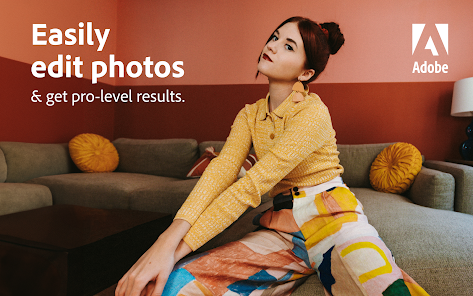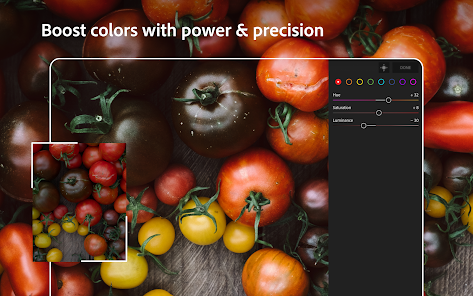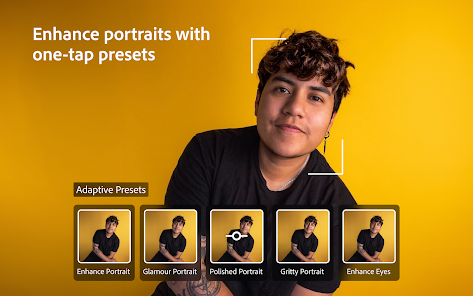Try Quick Actions for instant edit suggestions and your best photos yet.

Adobe Lightroom Mod Apk v10.0.1 (Premium Unlocked)
| Name | Lightroom Photo Editor |
|---|---|
| Publisher | Adobe |
| Genre | Photography |
| Size | 90 MB |
| Version | 10.0.1 |
| Update | Oct 14, 2024 |
| MOD | Premium Unlocked |
| Get it On |
|
| Report | Report Apps |
- Premium / Paid features unlocked
- Disabled / Removed unwanted Permissions/Receivers/Providers/Services
- Optimized and zip aligned graphics and cleaned resources for fast load
- Ads links removed and invoke methods nullified
- No Adobe ID Account Required
Preview
Adobe Lightroom has become a staple in the world of photography, serving both amateur and professional photographers alike. Known for its intuitive interface and robust set of features, Lightroom helps photographers organize, edit, and share their images seamlessly. Whether you’re touching up vacation photos or refining a professional portrait, Lightroom offers powerful tools to enhance your creativity.

Key Features of Lightroom
1. Photo Organization and Management
One of Lightroom’s most praised features is its ability to manage large photo libraries efficiently. Lightroom allows users to import, catalog, and organize their images in various ways. You can sort photos by date, location, keywords, ratings, and even add custom tags to make searching easier. With its intuitive library module, keeping track of thousands of photos is no longer overwhelming.
2. Non-Destructive Editing
Lightroom’s non-destructive editing process is a major advantage. It allows users to edit images without permanently altering the original file. All adjustments, such as exposure, contrast, and color corrections, are stored as instructions in the software, meaning you can always revert to the original version if needed.

3. Powerful Editing Tools
Lightroom offers a wide range of editing tools, from basic adjustments like exposure, white balance, and contrast to advanced features like graduated filters and spot removal. Some notable tools include:
- Exposure and Contrast Adjustments: These sliders allow you to brighten or darken your photo and tweak contrast for a punchier look.
- Color Grading: You can fine-tune the colors in your photos, adjusting highlights, midtones, and shadows for creative or natural looks.
- Clarity and Texture: These tools add depth and detail to your images, making textures pop.
- Selective Adjustments: Lightroom allows you to apply edits to specific areas of an image using radial filters, brushes, and graduated filters, giving you greater control.

4. Presets and Profiles
Lightroom’s preset feature is popular among photographers who want to speed up their workflow. Presets are predefined sets of editing adjustments that can be applied to an image with a single click. Lightroom comes with several built-in presets, and users can also create custom ones or download presets from third-party sources.
Profiles are another powerful feature that adjusts the overall tonality and mood of a photo. They can be used alongside presets to create a specific look, like cinematic or vintage styles.
5. Cloud Integration and Mobile Editing
With Lightroom’s cloud-based version, Lightroom CC, your photos are stored in the cloud, making them accessible across all your devices—desktop, tablet, and smartphone. The mobile version of Lightroom is particularly robust, offering most of the features available on the desktop. You can sync edits across devices, ensuring you can work on your photos anytime, anywhere.
6. Batch Editing
For photographers dealing with large sets of photos, batch editing is a lifesaver. Lightroom allows you to apply adjustments or presets to multiple photos simultaneously, drastically speeding up the editing process.

7. Sharing and Exporting
Lightroom makes it easy to export your photos for various platforms, from social media to print. You can choose from different file formats (JPEG, TIFF, etc.), resolution settings, and color profiles depending on your needs. It also supports direct sharing to services like Instagram, Flickr, and Adobe Portfolio.
Lightroom vs. Photoshop: What’s the Difference?
Lightroom is often compared to Photoshop, but the two serve different purposes. While Photoshop is more of a pixel-based editor used for detailed retouching and manipulation, Lightroom is built for streamlined workflows and global adjustments. Lightroom excels in handling large numbers of images efficiently, making it ideal for photographers who want to focus on color correction, exposure, and overall aesthetics.

Lightroom’s Subscription Model
Lightroom is part of Adobe’s Creative Cloud suite, which means it operates on a subscription-based model. You can either subscribe to Lightroom alone or as part of the Photography Plan, which includes both Lightroom and Photoshop. While some users may prefer the one-time purchase option offered by other editing software, Adobe’s continuous updates and cloud storage make the subscription worthwhile for many.

Lightroom’s Learning Curve
Though Lightroom is more user-friendly than Photoshop, there’s still a learning curve for beginners. Fortunately, Adobe provides extensive tutorials, and many online platforms offer free and paid courses that help users master the software. As you grow more familiar with Lightroom, you’ll find that the time spent learning is well worth the creative control and efficiency it brings.

Lightroom Alternatives
While Lightroom is a top-tier choice, there are alternative photo editing tools available, especially for users who prefer a one-time purchase model. Some popular alternatives include:
- Capture One: Known for its advanced color grading tools and tethering capabilities, Capture One is a favorite among professional photographers.
- Luminar AI: Offers AI-driven photo editing tools, making it easy for beginners to enhance images with minimal effort.
- Darktable: An open-source option that mimics many Lightroom features, ideal for users who want a free alternative.

Conclusion
Adobe Lightroom is an essential tool for photographers of all levels. Its combination of powerful editing tools, organizational features, and cloud-based mobility makes it a favorite in the photography community. Whether you’re new to photo editing or a seasoned pro, Lightroom provides the tools to bring your creative vision to life. By integrating non-destructive editing and advanced presets, Lightroom ensures your photo editing process is efficient, flexible, and creative.
For those willing to invest the time in learning its features, Lightroom becomes more than just software—it becomes a key part of your creative workflow.



